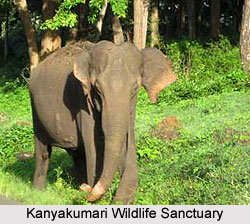 Kanyakumari Wildlife Sanctuary is located in Kanyakumari District is Tamil Nadu. Kanyakumari District is the southernmost tip of India. Kerala is situated on its north-west side, Tirunelveli District in north-east, Arabian Sea in the south-west, Bay of Bengal in the South east and Indian Ocean in the south. The forest got transferred from Kerala to Tamil Nadu on the 1st November 1956 due to state reorganization. The Kanyakumari Forest Division came into existence from 1st April 1977. Its headquarters is at Nagercoil. Government Reserved Forests occupy an area of 50486 ha of the Kanyakumari District. The important peaks here are Mahendragiri, Mottaichi peak and Varaittumudi.
Kanyakumari Wildlife Sanctuary is located in Kanyakumari District is Tamil Nadu. Kanyakumari District is the southernmost tip of India. Kerala is situated on its north-west side, Tirunelveli District in north-east, Arabian Sea in the south-west, Bay of Bengal in the South east and Indian Ocean in the south. The forest got transferred from Kerala to Tamil Nadu on the 1st November 1956 due to state reorganization. The Kanyakumari Forest Division came into existence from 1st April 1977. Its headquarters is at Nagercoil. Government Reserved Forests occupy an area of 50486 ha of the Kanyakumari District. The important peaks here are Mahendragiri, Mottaichi peak and Varaittumudi.
Geography of Kanyakumari Wildlife Sanctuary
Kanyakumari district has a pleasant general climate. The climate is greatly influenced by the south west and north east monsoon winds. Its proximity of the sea and the dwindling heights of Western ghats also affects the weather of this district. In Kanyakumari rainfall is distributed over four seasons, (a) South west monsoon i.e. during the months from June to September (b) north-east monsoon i.e. during the months from October to December (c) Winter i.e. during the months from January to February and (d) the hot weather summer seasons. In the hill region the rainfall is uniformly distributed. The maximum rainfall occurs during October and November. This district gets an average annual rainfall of 1369.5 mm with 79.7 rainy days.
Flora and Fauna of Kanyakumari Wildlife Sanctuary
Kanyakumari Wildlife Sanctuary constitutes the southern tip of the Western Ghats forests. The district constitutes of various forest types ranging from the Tropical Wet Evergreen forests to Southern Thorn Scrub forests. It is mainly due to varying rainfall from 50 to 310 cm and elevations from Sea level upto 1829 M. The sanctuary houses a variety of animals like Bonnet Macaque, Common Langur or Hanuman Langur, Nilgiri Langur, Leopard or Panther, Jungle Cat, Small Indian Civet, Mangoose, Jackal, Indian Fox, Dhole or Indian Wild Dog, Indian Elephant, Slender Loris, Tiger, Gaur or India Bison, Black Buck or Indian Antelope, Sambar, Barking Deer, Mousse Deer or India Chevrotain, Sloth Bear, Otter, Large Brown Flying Squirrel, Flying Fox, Indian Gaint Squirrel, Indian Porcupine, India Hare, Nilgiri Tahr, Chital or spotted Deer, Wild Boar, Pangolin.
Gradually, the developments made in this region like setting up of hydel projects and large conversion of natural forests into rubber plantation has significantly reduced the number of animals here. Encroachments and private estates here too have adversely affected the forest regions. This has led to reduction in number of animals like Tiger, Panther, Elephant, Black Buck and Deer etc.











